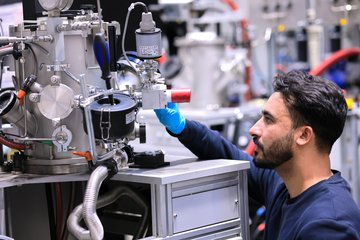All genres
2021.
Talk
A dislocation density based constitutive law for BCC materials in crystal plasticity FEM. 15th International Workshop on Computational Mechanics of Materials, MPI für Eisenforschung, Düsseldorf (2005)
2022.
Talk
Strain localization and microstructure evolution during plastic deformation of fiber reinforced polymer composites. International Workshop on Thermoplastic Matrix Composites (THEPLAC 2005), Lecce, Italy (2005)
2023.
Talk
Published in conference proceedings: Strain localization and microstructure evolution during plastic deformation of fiber reinforced polymer composites. International Workshop on Thermoplastic Matrix Composites (THEPLAC 2005), Lecce, Italy (2005)
2024.
Talk
Lattice Boltzmann studies of flow instability in microchannels: The role of the surface roughness/topology. Laboratoire de Physique et de la Matiere Condensee et Nanostructure, Universite Claude Bernard, Lyon1, France (2005)
2025.
Talk
Fundamental Research on Microstructure and Microtexture Development in Grain-oriented Silicon Steel: The Evolution of the Goss orientation. 17th Soft Magnetic Materials Conference (SMM17), Bratislava, Slovakia (2005)
2026.
Talk
Orientation and Crystallographic Texture of Calcite and Chitin in Lobster Shell. Euromat 2005, Prague, Czech Republic (2005)
2027.
Talk
Nanoindentation and Structure of Fibers of Lobster Cuticle. Euromat 2005, Prague, Czech Republic (2005)
2028.
Talk
Phase Formation and Microstructural Analysis of Fe3Al(Cr, Zr, Nb, C) Alloys During Thermomechanical Treatment. EUROMAT 2005, Prague, Czech Republic (2005)
2029.
Talk
Experimental Investigation on deformation of Oligocrystal Aluminum. Euromat 2005, Prague, Czech Republic (2005)
2030.
Talk
3D-Orientation Microscopy in a Combined Focused Ion Beam (FIB) - Scanning Electron Microscope: A New Dimension of Microstructure Characterisation. Microscopy Conference 2005, Davos, Switzerland (2005)
2031.
Talk
Experiments on the local mechanics and texture evolution of nanocrystalline Nickel. 14th International Conference on Textures of Materials (ICOTOM 14), Leuven, Belgium (2005)
2032.
Talk
Texture evolution of a Fe3Al alloy during thermomechanical treatment. ICOTOM14, Leuven, Belgium (2005)
2033.
Talk
A dislocation density based constitutive model for crystal plasticity FEM. 14th International Conference on Textures of Materials (ICOTOM 14), Leuven, Belgium (2005)
2034.
Talk
Texture and anisotropy of bio-composites. 14th International Conference on Textures of Materials (ICOTOM 14), Leuven, Belgium (2005)
2035.
Talk
A Texture Evolution Study Using the Texture Component Crystal Plasticity FEM. 14th International Conference on Textures of Materials (ICOTOM 14), Leuven, Belgium (2005)
2036.
Talk
Characterization of Nanostructured Electrodeposited NiCo Samples by use of Electron Backscatter Diffraction (EBSD). Conference on Textures of Materials ICOTOM 14, Leuven, Belgium (2005)
2037.
Talk
Microstructure and texture of the bio-composite material of the exoskeleton of homarus americanus (lobster). Fakultäts-Kolloquium der Fakultät für Geowissenschaften der Universität Göttingen, Göttingen, Germany (2005)
2038.
Talk
Introducing the Effect of Grain Boundaries into Crystal Plasticity FEM Using a Non Local Dislocation Density Based Constitutive Model. Theory and Application to FCC Bi-Crystals. Euromech Colloquium 463: Size dependent mechanics of materials, Groningen, Niederlande (2005)
2039.
Talk
Texture and smart anisotropy of the crustacean cuticle. Max Planck Institute for Metal Research, Stuttgart, Germany (2005)
2040.
Talk
Texture and Microstructure of biological composites. Keynote Lecture, GLAD-Conference Series on Materials Science between: The University of Delft, the University of Gent, the Katolike Universitaet of Leuven, RWTH Aachen and MPI für Eisenforschung GmbH, Düsseldorf, University Leuven, Belgium (2005)











